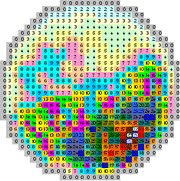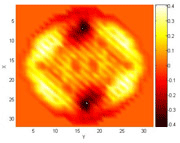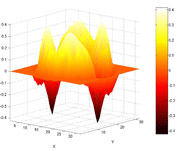 |
|
||
SENUBIO group > Neutronics and nuclear safety
Line 1. Study of nuclear reactors physical mechanisms and behavior
The objective of this research line is the comprehensive study of the physical mechanisms that take place in Nuclear Power Plants (NPP). The scenario for the future is more complex after the Fukushima accident which has led to new safety measures, also the long term operation of existing plants needs significant design changes.
The studies of this line are:
1. Complex transient analysis in nuclear power plants using coupled codes. RIA (Reactivity-Initiated Accidents).
- Coupling 3D thermal-hydraulic to neutronic mapping. In order to determine the fuel temperature and the moderator density in each of the nodes with a specific neutronics composition, it is necessary to establish a one-to-one correspondence between the thermal-hydraulics and the neutronics distributions.
- Development of coupled codes system (NTHVAL 3D). Modular code with: thermal-hydraulics modules (TRACE, TRAC/BF1, TRAC/PF1, RELAP5, RETRAN 3D, COBRA-TF), neutronics modules (VALKIN3D and VALKIN-FVM owned by ISIRYM, and comercial codes NEM and PARCS) and nuclear parameters generation (SIMTAB methodology owned by ISIRYM).
- Neutronics code VALKIN3D improvement: (1) Development of algorithms for the integration of the neutronic diffusion equation in hexagonal geometries for being able to simulate VVER nuclear reactors. (2) Study of alternative approximations for the transport equation like PL approximations, which are very useful when the fuel elements are heterogeneous or to reconstruct the neutronic flux inside the elements, considering their different composition (pin-by-pin reconstruction).
- Development of the neutronic code VALKIN-FVM: multigroup code to calculate advanced reactors. The code uses structured and unstructured meshes applied to all geometries, VVER reactors and advanced reactors. Moreover, the code uses the Volume Finite Method (FVM), ideal to couple with CFDs (Computational Fluid Dynamic codes) and the Finite Element Method (FEM). The code allowes the acceleration of the calculation with several CPUs by parallelization.
- Simulation of the most representative reactor transients, in order to be able to prove that the safety and licensing established criteria are met: ATWs (Anticipated Transient Without Scram), Rod Ejection Accident, Control Rod Drop Accident, etc.
- NEA (Nuclear Energy Agency) International Benchmarks: Peach Bottom Turbine Trip, ROSA LTF Facility, PKL and Oskarshamn-2.
- Participation in CAMP Spain program (Code Applications and Maintenance Program) under agreement NRC (Nuclear Regulatory Comission)-CSN (Consejo Seguridad Nuclear).
- Uncertainty and sensitivity analysis in the cross-section generation process, thermal-hydraulic parameters, etc. Participation in the UAM Benchmark (Uncertainty Analysis and Modelling).
- COBRA-TF / PARCS v2.7 coupling methdology. The advanced thermal-hydraulic sub-channel code COBRA-TF has been coupled with the 3-D neutron kinetics code PARCS v2.7 as a part of a multiphysics system code development for pin-wise level modelization and calculation.
- Development of a high performance multiphysics platform. Platform for the following codes: TRACE (termal-hydraulic system code), pCTF (own version of the COBRA-TF code, parallelization, optimization and improvements in models and correlations), PARCSv2.7 (neutron diffusion in 3D).
- Implementation of new capabilities in TRAC-BF1/NEM for considering boron dependent cross sections. Modifications performed in the 3D neutronics thermal-hydraulics coupled code, TRAC-BF1/NEM, in order to simulate the effects of the boron injections in BWR transient calculations.
2. Signal processing methods in local power range monitors (LPRMs).
- Calculation of the LPRM power signals has been implemented in the neutronics code PARCS, enabling a deepest knowledge of the local behavior of the core reactor. The analysis of these signals allows the comparison of the data obtained from the simulation with real plant data. Moreover, signal decomposition using SDV (Singular Value Decomposition) or ICA (Independent Component Analysis) techniques permits a more detailed analysis of oscillations during the transient.
3. Evaluation of BWR instabilities using coupled codes and Reduced Order Models (ROMS)
- Instability analysis has been performed in different BWR reactors: Oskarshamn, Peach-Bottom, Ringhals. For this purpose, the lambda modes of the core are obtained applying the VALKIN methodology. The core is excited spatially and/or temporarily following the pattern given by the lambda modes, for different amplitudes and evolution of perturbations.
Some specific results obtained through this research line are:
- SIMTAB5: software for Nuclear Parameters Generation.
- VALKIN: software for the resolution of the Neutronic Diffusion Equation.
Line 2. Nuclear fuel storage criticality analysis
The main target of this line is the development of new methodologies to optimize the nuclear fuel storage using SCALE and MCNP codes for criticality calculation in spent and fresh fuel element pools.
Line 3. Transport calculations in nuclear reactors
The main target of this line is neutron transport calculations with MCNP6 for simulating ex-core detectors response in a PWR reactor. Variance reduction techniques are applied for the calculation of the fluency in ex-core detectors.
 
|



